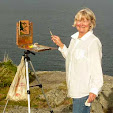November 2017 Day 2
3"x3" oil on acrylic primed paper
Generally oil painters don't work on paper. Chemically, oil paint and paper are enemies, over time the solvent and oil in the paint will literally eat the paper. Historically painters have added a protective layer between the paper and paint. Gesso, shellac, and acrylic paint are commonly used for this purpose. In the last few years paper makers have been helping out by creating papers that are treated to allow oil painting. I've tried both the Arches Oil Paper and Canson Canvapaper. I prefer the Canvapaper, though both of them absorb the paint much more than a gessoed canvas. It's annoying to be unable to scrape paint off the surface the way you can on canvas or board.
Why paint on paper? It's less expensive than canvas or board, and you can cut it to any size you want. I love that flexibility! Because of the cost advantage it's great for experimenting, and it allows us to offer paintings at a lower price point.
I recently did some experiments to try and create a surface that I enjoy painting on with Canson's Canvapaper. In this case, I didn't need to protect the paper from the paint, but wanted to create a surface that I can remove paint from as well as add paint to.
I tried these coatings:
1) thin burnt sienna oil paint
2) thin transparent red oxide acrylic paint
3) acrylic white paint
4) acrylic burnt sienna and white paint mixed
5) acrylic transparent oxide red and white paint mixed
6) white gesso (to make this work, you need to apply the gesso to both sides of the Canvapaper, otherwise if will buckle)
My favorite is #5, the mixed transparent oxide red and white acrylic paint. The acrylic paints (numbers 3-5) gave a good surface in terms of removal of paint, but the burnt sienna mixture is too cool for my taste. I might use the white acrylic paint when I want to create a glow with a thinned layer of oil paint. For most of my paintings, I like to work on a warm surface. I use thinned burnt sienna oil paint, which I wipe off with a paper towel, to provide this on canvas.
November 2017 Day 1
3"x3" oil on acrylic primed paper
I'm using #5 for my 30 Paintings in November this month. I'll be painting a mini-painting every day, with the idea of saying a lot in a small format, and experimenting with composition, value, and color. I'm learning a lot already!
You can follow along with me on Instagram (@bobbiheathart) or Facebook (https://www.facebook.com/bobbiheathartist/). And if you aren't fond of those, I'll be happy to email them to you. Just let me know at bobbiheath@gmail.com that you're interested.
The collection will be available on December 1st for $35 each, which free shipping in the US for blog and newsletter subscribers.

















































